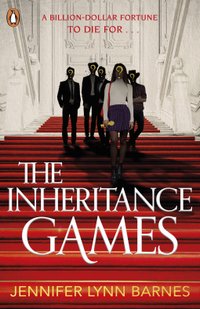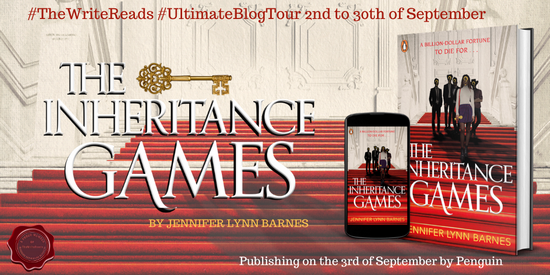 |
The Inheritance Gamesby Jennifer Lynn Barnes eARC, 372 pg. Read: September 11-12, 220 |

What’s The Inheritance Games About?
We begin by meeting Avery, a high school junior on a mission. She’s determined to get through high school without drawing a whole lot of attention (good or bad), to fly just under everyone’s radar—but to do so in a way that’ll pick up enough in scholarships to get to college and get to a stable and lucrative career (in actuarial science). Once she’s there, she can take time to breathe, time to relax. But not until then—now it’s about studying, working, and hopefully getting to help out the older sister that she lives with.
And then a mysterious—and obviously stinking rich—stranger shows up and tells her to get on a plane to Texas where she needs to be at the reading of a last will and testament. She knows no one in Texas, has never heard of the deceased, and can’t think of why she needs to be there. But hey, it’s a free trip for her and her sister (and she’s curious about the will).
The deceased is Tobias Hawthorne, a billionaire. With a B. He was the richest man in Texas and among the richest in the world. It turns out that he’s left almost everything to Avery. If she can live in his mansion (the word mansion doesn’t seem to cover it, but English doesn’t have a word that’d actually describe the place) for a year.
The difficulty in that lies in the rest of the household—there’s the staff who don’t seem all that welcoming, Hawthorne’s daughters and son-in-law who clearly resent the interloper, and Hawthorn’s four grandsons (all around her age) who were the presumptive heirs before she came along.
Avery and the grandsons (and, actually, pretty much everyone in the world once the story breaks) just want to know one thing—why her?
The Characters
I’ve been thinking all week about how to talk about the characters in this book, and I think the best way to get a handle on them is to think of them in three tiers (and as soon as I write that sentence, I think of a way to separate them into four, or maybe five, so admittedly, there are problems with this approach, but I’m sticking with it),
Tier One is simple: Avery and the four Hawthorne grandsons—Nash, Grayson, Jameson, and Xander. They aren’t as all well-drawn as the others (Avery, in particular), but any time they’re around, the reader and the scene focuses on them over everyone else. The novel is about them, everyone else is a supporting character. More than the other Tiers, each of these characters has an obvious goal, an obvious storyline, a motive to find out what Hawthorne was doing with this will. They’re three-dimensional characters (Nash could use some more definition, though). It’s hard to like them all consistently, but you can’t help but be curious about each of them.
Tier Two consists in Libby, Avery’s sister; Oren, her security chief; Alisa, the lawyer/primary contact with Hawthorne’s law firm (and Nash’s ex, but that’s another story); and Max, Avery’s best friend (who she only communicates with via text and telephone throughout the novel). It occurs to me that this group consists of people that Avery trusts (maybe she should, maybe she shouldn’t, but they haven’t given her a reason not to). We know them a little better than the rest, but the focus on them isn’t as great as it is on the Tier One characters. Of these, I really wanted more time with Max—and hope that the story will allow more interaction with Avery and Max in the sequels.
Tier Three is everyone else—people from their schools, consultants/employees of the estate, and well, anyone else who shows up. Most of these are little more than names and titles—some are filled out a little bit, but few are more than a two-dimensional sketch. If they get more than two dialogue lines, they’re interesting, and you typically want to know more about them and hope that Barnes finds an excuse to use them some more (with the exception of Libby’s boyfriend, who you just hope never to hear from again, every time he makes an appearance). Some of these may be trustworthy, but you have almost no reason to trust anyone on this Tier (Libby’s boyfriend is the exception—you have absolutely no reason to trust him). This is an interesting quirk of this world—there are precious few people that the sudden-heiress can trust, everyone has an agenda dealing with her, usually a hidden one.
Of course, looming over everything is the specter* of Tobias Hawthorne. As he’s dead, I don’t count him as a character. But his personality, his achievements, his machinations govern everything. As Xander notes (and Avery frequently remembers), even if she’d manipulated Tobias into this, she’d find he was manipulating her all along.
* Not literally, this isn’t that kind of book.
You take the large cast of characters that this represents, using them all (particularly Tier Three) as pieces of the puzzle themselves–and all of them providing multiple clues of various quality to the big question, and the word “complex” almost doesn’t cover the nature of this puzzle.
A Thought about Genre
I keep seeing references to this as a thriller. It is absolutely not a thriller. There are moments that could be seen as belonging to that genre, but they’re so brief that they don’t count.
This is a puzzle, this is a mystery, this is a mental exercise, a riddle. It’s practically a cozy (closer to one than it is a thriller, anyway).
That’s not a criticism of anything but the marketing. But anyone walking into this should not be expecting pulse-pounding tension, breakneck speeds (although it is generally fast-paced), and nail-biting action. This novel about the characters, it’s about figuring out motives, and the meaning of various acts.
So, what did I think about The Inheritance Games?
I picked this up just to read a chapter or two in order to get a flavor for it, then I was going to put it down for the evening, and pick it up again the next day. I ended up reading 30% of it before I had to stop—and read almost another 20% that night. It’s engaging, it’s smooth, it’s so, so, readable.
The pages just melt away and you get swept up in the story—as outlandish as it is. Without any effort, you not only suspend your disbelief, but you put a gag on it and stuff it in a closet somewhere.
There’s a definitive end, a puzzle is solved, and there’s a sense of resolution. Which is immediately replaced with the next puzzle and a promise of more to come in the sequel. So while I don’t think you can call it a cliff-hanger, you can definitely see the cliff just ahead on the path.
I’m a little annoyed that I saw The Westing Game referenced a few times in the marketing for this book. Because I really wanted to talk about the way that this had a similar feel to The Westing Game and be able to come across as insightful to do so, Instead, I’m just part of the echo chamber. Still, there’s a very Westing Game-vibe to The Inheritance Games, and as there are few books that I consider as clever, as well constructed, and as readable as Raskin’s book, that’s a high compliment.
This is just a fun, fun read. Pick it up.
My thanks to The Write Reads for the invitation to participate in this tour and the materials they provided via Penguin Random House Children’s UK and Netgalley.





1 Pingback